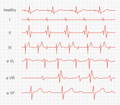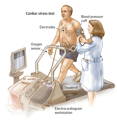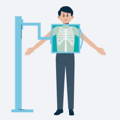Take A Look at Your “Heart” - Medical Tests for Heart Disease
Take Care of Your "Heart"!
Chest tightness, palpitations, shortness of breath... Do these symptoms mean heart disease? How can you test for heart disease?
Heart Disease - Top Killer of Human Health
AHeart disease has become a top killer of human health. Every year, 17 million people died of heart disease, taking up one-third of all deaths worldwide. (Reference: https://www.healthknowledge.org.uk/public-health-textbook/disease-causation-diagnostic/2b-epidemiology-diseases-phs/chronic-diseases/coronary-heart-disease)
In recent years, the increasing incidence of heart disease has seriously affected our physical and mental health. If relevant tests are not performed in a timely manner, it may have seriously bad results and even directly threaten lives.
Therefore, it is especially important to understand the routine detection methods of heart disease to detect heart abnormalities earlier and prevent heart disease.
Medical Tests for Heart Disease are Helpful for Diagnosis
One himself can detect most of the early symptoms of heart disease, such as a feeling of pressure in the chest, palpitations, shortness of breath and a gray and purple face when doing light exercises. If you find the above symptoms occur frequently, you’d better do some tests to achieve early examination and treatment.
So, are chest tightness, palpitations and breathlessness heart problems? How to confirm the diagnosis in the end?
Let's take a simple look!
1. Resting electrocardiogram (ECG)
Resting electrocardiogram, the most commonly used non-invasive test, can detect a variety of abnormal heart rhythms. This test has a higher detection rate when the patient's symptoms occur. However, if the test is performed during a missed episode, it may show a normal ECG.
See Wellue's EKG Monitors
3 Days before it ends!
Get 10% off with code: HEART4
6 Reasons to choose Wellue’s EKG Monitors:
a. Some with a screen, it can do recordings RIGHT AWAY without connecting via bluetooth to a phone.
b. Recording duration options are provided: 30s / 60s / 5 mins /30s - 5 mins / 30s - 15 mins
c. Small & Portable & Unobtrusive.
d. Built in battery with long life is rechargeable.
e. Reports of ECG in free APP or PC Software are saved. It can make recordings without “upsell” to get your recordings.
f. Built-in memory function
2. Holter
An ambulatory electrocardiogram (Holter), also called a long-term ECG, provides information about a patient's dynamic ECG activity over a long period of time, at least 24 hours. It complements the inadequacy of resting ECG by obtaining continuous ECG data for 24 hours or longer. By providing a clear picture of the relationship between the patient’s medications taken and the ECG changes, Holter ECG enables an effective determination of the patient’s heart health, with a combination of the patient's activity diary.
See Wellue's 24-Hour ECG Recorder with AI Analysis
This AI-powered heart monitor greatly helps guard the heart, providing similar information to the Holter monitor.
3 Days before it ends!
Get 10% off with code: HEART4
- Continuously monitoring ECG for 24 hours or even up to 72 hours, recording up to 360,000 ECG signals.
- Powerful AI algorithm interprets the recorded ECG. Makes it easy for everyone to understand. It can intelligently diagnose 16 categories, such as arrhythmia, more than 104 kinds of abnormal ECG/EKG events.
- PDF reports can be easily shared with doctors, help to save time and money.
- Rechargeable battery with super long life.
- Comfortable wearing with flexible material
- Lightweight and portable
3. Cardiac Exercise Stress Test / Exercises ECG (Treadmill ECG)
The cardiac exercise stress test is one of the diagnostic methods for early coronary artery disease. Although there is some error in comparison with the results of coronary angiography, this method is still recognized as an important clinical test because it is convenient, safe, and non-invasive.
The Treadmill ECG is the most widely used, and it can be a good way to know the blood supply problems of the heart during exercise and the abnormal ECG that cannot be easily detected in a calm state. Doctors can find the relationship between arrhythmia and exercise by observing the occurrence of arrhythmia during exercise.
4. Echocardiography
Echocardiography uses the properties of sound wave reflection and the scanning technology of radar. The reflections of ultrasound waves passing against different structures of the heart are displayed to form images.
Close to 90% of congenital heart diseases can be diagnosed definitively by echocardiography. It is unique for the diagnosis of rheumatic heart disease, congenital heart disease, cardiomyopathy, and heart failure.
See Wellue's 24-Hour ECG Recorder with AI Analysis
5. Cardiac Enzyme Test
Cardiac enzyme testing is one of the most important tools for the diagnosis and differential diagnosis of acute myocardial infarction.
Clinical diagnosis of acute myocardial infarction is based on serial changes in serum enzyme concentrations and elevation of specific isoenzymes.
6. Coronary Angiography
Currently, coronary angiography is the gold standard for checking cardiovascular health.
It requires an invasive technique to establish a pathway from the patient's femoral or radial artery to the coronary artery. The contrast material is injected into the coronary artery to visualize the main branches of the heart's coronary arteries through the X-ray camera, helping doctors to determine the presence, location, degree, and extent of stenosis in the coronary arteries.
The results of the test are very visual, but it will be more expensive, and at the same time, there is a certain risk as it is an invasive test.
Summary
These are the common tests for heart disease, now you know why doctors want you to have so many tests! Remember that the treatment of heart disease is focused on prevention.











